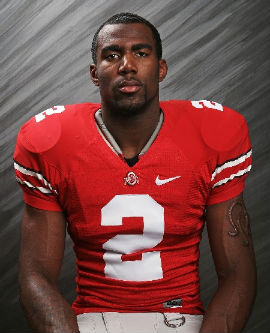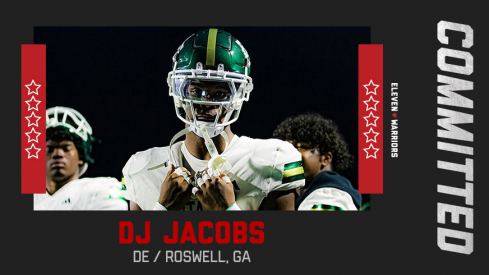 From three-star to Thorpe winner.
From three-star to Thorpe winner.National Signing Day is less than a week away and while fans of teams across the country are tracking everything from Facebook postrings to the eating habits of the five-star they're hoping to close on, Doctor Saturday is out with his yearly look at the merits of the various recruiting services. What he found, and what he's found pretty much every year he's run these numbers, is that while a five-star recruit is not gauranteed to become an all-American at the next level, the odds of said recruit earning that honor are significantly higher than four- and three-star recruits:
Maybe a raw ratio of 1 in 13 – or even 1 in 10, or whatever the "adjusted" number is after accounting for the early departures, injuries and academics that these numbers make no attempt to reflect – isn't all that impressive by itself. After all, that means far more elite recruits are falling short of their star-studded birthright than are reaching it. Across the board, failure and mediocrity are the norm, but if you think of a four or five-star player as a guy who is supposed to become an All-American – and a two or three-star guy as someone who is definitely not supposed to become an All-American – then yes, the rankings frequently miss.
On the other hand, if you consider the initial grade as a kind of investment – a projection of the how likely a player is of becoming an elite contributor compared to rest of the field – well, you'd put your money with the "experts" over the chances of finding the proverbial diamond in the rough every tim
Though four- and three-star recruits made up 74.5% of all players named to at least one All-America team from 2006-2010 and five-stars were just 19.9% of the same group, the math supports the notion that five-stars are more valuable lottery tickets.
It's always interesting to see these numbers for the nation at large, but what about the numbers viewed in a Buckeye vaccuum? We all know about former three-stars like James Laurinaitis and Malcolm Jenkins capturing All-American honors, but what about the rest of the players that pledged to play for Jim Tressel?
We compiled data from every full recruiting class in the Tressel era, 2002-2007, and for the sake of this exercise, we stuck with Rivals' rankings so our datasets would be consistent.
First, let's take a look at players that earned All-American honors:
| 5-Star | 4-Star | 3-Star | 2-Star | 1-Star | |
|---|---|---|---|---|---|
| Total Players | 5 | 49 | 30 | 6 | 2 |
| % of Total Players | 5.43 | 53.26 | 32.61 | 6.52 | 2.17 |
| All-American Players | 2 | 2 | 3 | 0 | 0 |
| All-American Selections | 2 | 2 | 6 | 0 | 0 |
| Odds of Being Named All-American | 1 in 3 | 1 in 24 | 1 in 10 | 0 | 0 |
Compared to other FBS schools, OSU recruits have a better chance of making an All-American team. Five-star recruits have a 1 in 3 chance of becoming an All-American under Tressel, compared to a 1 in 13 chance for the national set. Likewise, four-stars at OSU have 1 in 24 odds of being named All-American while their counterparts from around the country have 1 in 53 odds. Where this is most pronounced, is the work Tressel has been able to do with three stars. Thanks to guys like Laurinaitis and Jenkins, Buckeye three-stars have 1 in 10 odds of being All-Americans compared to just 1 in 172 odds when including every school in the country.
Now, let's take a look at the players that earned all-Big Ten honors:
| 5-Star | 4-Star | 3-Star | 2-Star | 1-Star | |
|---|---|---|---|---|---|
| Total Players | 5 | 49 | 30 | 6 | 2 |
| % of Total Players | 5.43 | 53.26 | 32.61 | 6.52 | 2.17 |
| All-Big Ten Players | 3 | 12 | 7 | 0 | 0 |
| All-Big Ten Selections | 3 | 13 | 13 | 0 | 0 |
| Odds of Being Named All-Big Ten | 1 in 2 | 1 in 4 | 1 in 4 | 0 | 0 |
Moreso than the All-American nods, the data seems to suggest that you have a 50/50 chance of being named all-Big Ten if you arrived at Ohio State as a five-star. Further, the numbers are once again boosted by Laurinaitis and Jenkins and their multiple all-Big Ten selections, but if you come to Columbus as a three-star, your odds of being named all-Big Ten are nearly as good as they are if you are a four-star under Tressel.
Finally, let's look at the NFL draft:
| 5-Star | 4-Star | 3-Star | 2-Star | 1-Star | |
|---|---|---|---|---|---|
| Total Players | 5 | 49 | 30 | 6 | 2 |
| % of Total Players | 5.43 | 53.26 | 32.61 | 6.52 | 2.17 |
| Players Selected | 3 | 18 | 9 | 1 | 0 |
| 1st Round Selections | 2 | 5 | 3 | 0 | 0 |
| 2nd and 3rd Round Selections | 1 | 2 | 2 | 0 | 0 |
| 4th - 7th Round Selections | 0 | 11 | 4 | 1 | 0 |
| Odds of Being Drafted | 1 in 2 | 1 in 3 | 1 in 3 | 1 in 6 | 0 |
The draft is such a crapshoot for various reasons: players leave school much different people than they enter, All-Americans and major award winners slide if they run slow in Indy, etc., but once again, the better the pedigree of a recruit coming to Ohio State, the better his odds of being drafted. But, for every five-star Robert Rose or Alex Boone that arrives on campus, there's a two-star Donald Washington that works his way into a nice payday.
Overall, the numbers for Ohio State recruits support Dr. Saturday's findings, though playing for one of the blue bloods of the college football world seems to significantly enhance one's odds of earning postseason awards. Oh, and good, fundamental coaching never hurt anyone, either.
Some notes about the data used:
- The set excludes players that didn't qualify after signing day as well as players that didn't finish at Ohio State because of transferring, injuries or academics. Maurice Clarett was one of the five-stars Tressel signed and played an important role in the 2002 season, but is not included.
- Buckeyes that were unranked by Rivals (Pettrey, etc.) were awarded one star for the purpose of this study.

